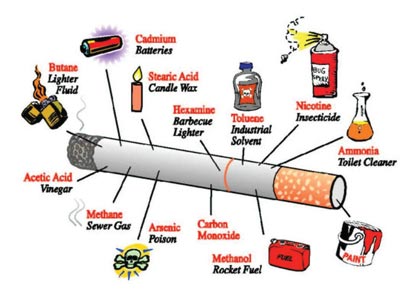|
Health Watch
Thank you for not smoking :
Banning smoking in workplaces good for your heart
The World Health Organization says that smoking killed 100 million
people of the world in the 20th century. If Governments and concerned
organizations do nothing to reverse current smoking trends in the world,
tobacco could kill 10000 million (1 billion) people in the 21 century.
Of this 1 billion 50 percent would be those living in developing
countries in Asia including Sri Lanka. In our country about 20,000
people die each year of tobacco related illnesses, especially heart
disease. In World Heart Day which falls on September 27, we should
resolve once again to do all we can to control the menace of tobacco in
the world.
Secondhand smoke
 Many people have heard the slogan ‘your cigarette is killing me. This
statement is in fact expresses a well established truth. The smoke that
a smoker releases from his lungs into the environment goes also in the
lungs of non-smokers in the environment. Such smoke is called secondhand
smoke. The deadly poisons that tobacco smoke contains passes from the
lungs into the bloodstream of those who inhale it. Many people have heard the slogan ‘your cigarette is killing me. This
statement is in fact expresses a well established truth. The smoke that
a smoker releases from his lungs into the environment goes also in the
lungs of non-smokers in the environment. Such smoke is called secondhand
smoke. The deadly poisons that tobacco smoke contains passes from the
lungs into the bloodstream of those who inhale it.
If a pregnant woman inhales this secondhand smoke some of the poisons
in the smoke she inhales will reach her unborn baby through her
bloodstream. There are more than 4,000 chemicals in tobacco smoke. Of
these about 50 have been proved to be carcinogenic, that is to say,
capable of causing cancer in various organs of the body including the
lungs.
Poisons inhaled
It must also be remembered that there are other chemicals which can
damage the heart and the blood vessels. So it is true to say that
tobacco smoke where inhaled actively or passively is a major risk factor
for heart disease.
Do you know that tobacco smoke contains Nicotine, DDT, Arsenic,
Carbon Monoxide, Hydrogen cyanide, Cadmium and Formaldehyde? Nicotine is
used commercially to make poison to kill cockroaches. DDT is a well
known killer of mosquitoes. Arsenic is a poison which people have used
to kill their enemies in slow stages by adding it to their food. Carbon
monoxide is a poisonous gas found in car exhaust fumes. Hydrogen Cyanide
was used in the suicide capsules of LTTE cadre.
There is evidence that cadmium maybe the poison that is causing
serious kidney diseases of many people in the North Central Province.
Formaldehyde is used to embalm dead bodies.
Further examples are unnecessary to convince intelligent people that
those who smoke in public places are not only slowly killing themselves
(suicidal) but also slowly killing others (homicidal). If there are
pregnant women in the environment then the behaviour of smokers becomes
infanticidal as well.
Isn’t it a crime to allow people who smoke in workplaces to continue
to indulge in their criminal behaviour?

NATA Act
The National Authority of Tabacco and Alcohol Act No. 27 of 2006
became operative from December 1, 2006. According to Section 39(1), “No
person shall smoke or allow any person to smoke any tobacco product
within any enclosed public place. Any person who being the owner,
occupier, proprietor, manager, trustee or person in charge of any
enclosed public place shall ensure that no person smokes any tobacco
product within any such enclosed public place”.
Whether all workplaces are ‘enclosed public places’, is a legally
debatable matter. Steps have therefore been taken to amend the Act to
prohibit smoking in all public places. Predictably the merchants of
death in the tobacco industry will do all they can to oppose such an
amendment.
There is no doubt, however, that the overwhelming majority in the
country will support such an amendment. There is no doubt, however that
the overwhelming majority in the country will support such an amendment.
It is line with the expressed intention of President Mahinda Rajapaksa
to make Sri Lank free of tobacco smoke by 2015.
ILO
Exertion: leading to relax your mind
Tudor Welikala
Recently I telephoned a friend who had been ill with Parkinson’s
disease for almost ten years. His wife answered the phone in a weepy
voice and said, “your friend has departed.”
Actually I had been expecting such an answer for some time. He was
one year younger than me. I am seventy seven now.
When one reaches seventy, one sees that one’s contemporaries are
being taken away by the ‘grim reaper’ at an extraordinary increasing
rate. All my first cousins have passed away. My only other sibling who
was one year younger than me passed off last year. I am now like “the
boy who stood on the burning deck, whence all but he had fled.”
 All these departees had one thing in common, a disinclination to
exert themselves. On the contrary I had engaged myself in daily physical
exercise since I can remember. My cholesterol level and blood sugar
levels are normal. There is no urine sugar, and the blood pressure is
70/180. All these departees had one thing in common, a disinclination to
exert themselves. On the contrary I had engaged myself in daily physical
exercise since I can remember. My cholesterol level and blood sugar
levels are normal. There is no urine sugar, and the blood pressure is
70/180.
I still ride my Honda trail bike, practise on the punching bag and
drive the car. Not only do I do regular physical exercise, I also read
and write articles on various subjects which often get published in the
newspapers. I take half a bottle of local brandy once in four or five
days, eat large quantities of wild herbs for breakfast with rice and
lentils. Eat bread and fish or meat for lunch. I eat only two meals a
day, and don’t take any food after 1.00 p.m. At dinner time I do half an
hour of exercise, including lifting 10 kg of weights. I dislike eating
any kind of fruits, unless they are cooked.
When my doctor told me to “bed rest” for a back ache ten years ago,
the doctor being an old friend, I told him that contrary to his
recommendation, I was going to continue exercising. I am not in any way
suggesting that one shouldn’t follow one’s doctors orders. But my
backache healed with exercise.
Many people especially, sedentary workers have a day of retirement
from which day, those people end up becoming sluggish. Some get out of
bed long after sunrise. Eat, lie down again, have lunch, sit or lie down
again, and eat a big dinner before going to bed. This routine is a
summon to death.
The ancient Greeks personified death as Thanatos. The Romans called
him mors. In Sanskrit he is Mrthyu, in Sinhala he is Mara. By whatever
name death is known he can, be kept at bay. One doesn’t have to die at
77 or 87 even 107. According to Vijnanavada in Mahayana Buddhism, only
consciousness or mind is real. Thought or mind is the ultimate reality.
If the mind becomes slothful, it won’t be able to keep death away, if
you are seventy now it won’t be easy to get even into the partial Yoga
mode, in which I have been living for many years.
Being a Yogi doesn’t mean that one has to renounce the world and
become a sanyasin, a holy man who is a homeless mendicant wearing
clothes made from cloth taken from the rubbish heaps, and possess only
three robes, an alms bowl and a needle and water strainer to filter
insects from the drinking water (so as not to kill or imbibe them)
regarding straining flies, the Bible says in Matthew 25:24 “you strain a
fly!” If you want to live to be a hundred and still be riding motor
bikes, you can’t be with a bulging abdomen, you have to be slim and
alert and have your reflexes like a good boxer, saying which, I am
reminded of a 65 year old relative and his wife who told me recently,
when I told them to exercise, (which I tell all my acquaintances, just
as I am trying to tell the world through your newspaper) the man told me
that all his joints were stiff and exercising was out of the question.
Thanatos will take him to his fold soon.
The human eye as well as the eyes of all animals are held in place by
muscles, if the eyes are not exercised a seventy seven years old man’s
eyes will sag and “old age” will show. Yoga has exercises for the eyes
too. They include the Hindu “temple dancers” eye movements. In Yoga
there are exercises for the voice too. Yoga chantings like “Om” and
other long chants, recitation, or even singing will keep the
youthfulness of the human voice.
So I wish everyone who reads this will keep standing on “the burning
deck” till he is at least one hundred year old.
 Sleep walking Sleep walking
A little girl aged 10 years walks in her sleep. She is so clever that
she even opens the doors and walks. What is the reason for this?, What
are the precautions?, What is the Treatment.
To whom has she be shown, a psychiatrist or a paediatrician?
Anxious relative. - S.A. Ediriweera.
Dr. Dennis J. Aloysius replies:
We referred to your question to Dr. Dennis Aloysius. His reply is:
Sleep walking is also called Somnambulism. This occurs more commonly in
childhood, and it could also persist into adult life.
This happens in a semi automatic way to a person during sleep.
Usually the person has no memory of doing it.
This can occur as a result of stress and its behavioral disturbance.
The affected person walks with the eyes open without any evidence of
recognition. Get the child seen by a psychiatrist with special interest
in children.
Stress at work place
Dr. S.A.I.K. Suraweera
Stress, in general and occupational stress, in particular, is fact of
modern day life. It is inevitable in life, and with increasing
complexities, aspirations and uncertainties associated with
socio-economic, political and cultural upheavals, stress is only likely
to increase. It is important to appreciate that stress arises from
various sources.
Stress can be caused by environmental, organizational and individual
factors. Stress arising as a result of the occupation, constitute a
large proportion of the overall stress response, since over 75 percent
of non-sleeping time in adults is devoted to job activities.
Work stress can be defines as the harmful physical and emotional
responses that occur when the requirements of the job do not match the
capabilities, resources, or needs of the worker. Clearly, unresolved
stressful situations keep a body in a constant state of activation and
increase the likelihood of ‘wear and tear’ to biological systems.
Fatigue results as a compromise in the body’s ability to defend itself;
and an increased risk of illness, injury and disease have all been found
to escalate with stress (National Institute of Occupational Safety and
Health - NIOSH 1999).

It can be seen that employees well-being can be disrupted by
psychological, physiological and behavioral dimensions of the stress
response. Studies have shown that occupational stress can lead to
suicides, sleeping problems, depression, anxiety and burnout. Several
studies over the last fifteen years have provided support for the
involvement of stress as a risk factor for illness and disease.
Duyton (1981) postulated that a person who experiences long-term or
chronic stress may potentially experience such debilitating illnesses as
hypertension, coronary heart disease, stroke, diabetes and peptic ulcer.
It can also adversely affect the reproductive functions of workers
(Pelletier et al 1999). Job stress in general has been associated also
with musculoskeletal disorders, diabetes, cancer, gastrointestinal
illness, cardiovascular mortality and alcohol related illnesses (Johnson
1996).
In addition to stress ill effects, a number of studies have found out
that occupational stress is associated with unhealthy behaviours such as
smoking, physical inactivity and unhealthy eating patterns. Some
individuals might turn to substance abuse and chemical dependency to
treat their occupational related stress (Pelletier et al 1999).
It is well-known that stresses as well as the associated unhealthy
behaviours are major risk factors for most of the non-communicable
diseases.
Stress is, therefore, held to be causally responsible for a vast and
varied range of negative health outcomes that not only affect the
individual, but also the employer and society in general. These outcomes
contribute to the hidden costs of stress in the workplace that are
difficult, if not impossible, to quantify.
Over the last decade occupational stress, has become an issue of
great concern world over. It is a concern not only for employees in the
developed and affluent countries but is also a common concern among
developing countries in the world.
While stress at work is more frequently considered in the context of
the industrialized countries, it is quite clear that workers in the
developing countries are also undoubtedly affected (ILO 2001).
The writer is Senior Registrar in Community Medicine, Ministry of
Healthcare and Nutrition.
|



